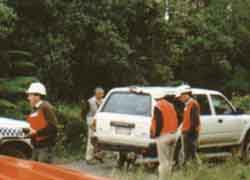Reclaiming our forests from DNRE
"Forestry workers" in the Department of Natural Resources and Environment
(DNRE) often describe themselves as being involved in "forest management".
The bulk of DNRE activity is involved in timber management which
means turning forest into plantations. These "forestry workers"
should really be called "plantation creators". Their work mainly
involves construction and maintenance of roads for log trucks and
supervision of tree felling and crop seeding in logging coups. With
the way they are currently managed, most of the Otway state forest
will eventually become a plantation with the forest ecology manipulated
and simplified to suit the needs of the timber industry. Though
it is denied, they see the Otways as a tree crop.
This image is not particularly acceptable within the general
public who like to think that the forest is not being altered
and its values diminished. So to try and keep the public happy
the Government and DNRE bureaucracy have created and finalised
the Otway Forest Management Plan (FMP), which contains management
plans for both conservation and commercial exploitation of public
forest. Submissions from the whole community were sought and included
in the FMP to try and address most interest groups concerns and
issues. The DNRE bureaucracy often holds up the plan when asked
about its management of the Otways and signals everything is covered.
However DNRE does not act on conservation issues outlined in
the FMP if these issues conflict with commercial timber management.
There have been many occasions where the plan has been flouted.
Local environments also believe that their submissions to the
FMP was not adequately considered.
The following points highlight how the FMP is simply a smokescreen
used by DNRE and the woodchipping industry to distract the public
while the forest ecology continues to be modified.
1. Chalara australis (Myrtle Wilt)
In section 8.4.3 of the FMP, DNRE acknowledges Myrtle Wilt as a
problem in Otway cool temperate rainforest and gives HIGH PRIORITY
to -
"investigate the impact of Myrtle Wilt on rainforest floristics
and its rate of spread in relation to the extent and type of disturbance
in rainforest".
The DNRE neglected to give myrtle wilt high priority when it
ignored and then altered the Cameron and Turner report "Surveying
and monitoring Myrtle Wilt within Cool Temperate Rainforest in
Victoria" (See Myrtle Wilt fact sheet). The Otway FMP should not
be used as a vehicle to test whether the disease is sperding,
but rather to control its spread.
2. Sites of Significance.
The DNRE plans to log 5 coups, (total of 75 Ha) within Sites of
Significance (SOS) in the Otway ranges in the 96/97 logging season.
SOS are areas rated National, State or Regional SOS. They contain
the best and most sensitive stands of cool temperate rainforest
in the Otways (Cameron 1990). The Sites of significance are acknowledged
and listed in the Forest Management Plan (Section 6.2.1.). Reference
to (Cameron 1990) reveals he made sound recommendations that logging
should be excluded from Sites of Significance.
3. Water Quality and Landslides
The DNRE ignore section 6.4 Land Degradation. The objectives of
the department are to:
"Protect land from degradation that may be caused by forestry
management practices. Protect streams from the effects of unnatural
land degradation by minimising turbidity and sedimentation."
There is no prevention management strategy for landslides in
the FMP. The FMP accepts that landslides are unpredictable and
inevitable due to logging operations. The FMP only offers advice
after the event. Section 6.4.4 of the plan states: -
"Roads and tracks potentially cause more hazards with regard to
soil losses and water quality degradation than actual harvesting
operation itself."
"Some hazards may not be apparent until after heavy rainfall;
coupe and rehabilitated tracks and roads should be inspected during
the wet season after logging to anticipate or prevent potential
major soil movements."
|


